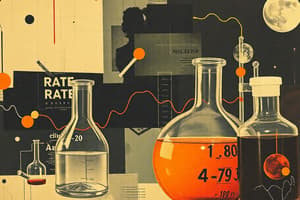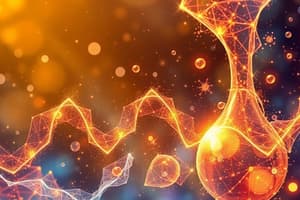Podcast
Questions and Answers
What primary role did the stone found in Khuan Luk Pat, Thailand, likely serve, based on the inscription and Tamil literature?
What primary role did the stone found in Khuan Luk Pat, Thailand, likely serve, based on the inscription and Tamil literature?
- A religious artifact used in temple rituals to bless new settlements.
- A writing tablet used for recording trade transactions between merchants.
- A commemorative marker denoting the boundaries of Suvarna Bhumi.
- A touchstone used by a goldsmith named Perumpattan to assess gold purity. (correct)
How did the process of urbanization during the Sangam Age affect the occupational structure of the population, differentiating urban centers from rural settlements?
How did the process of urbanization during the Sangam Age affect the occupational structure of the population, differentiating urban centers from rural settlements?
- Urban centers maintained a primarily agrarian economy.
- Rural settlements expanded to include large-scale industrial production.
- Both urban and rural areas focused equally on agricultural and artisanal occupations.
- Urban centers saw a concentration of population engaged in non-agrarian activities, commerce, and political administration. (correct)
Based on archaeological findings, what can be inferred about the maritime trade connections between Tamil Nadu and other regions during the Sangam period?
Based on archaeological findings, what can be inferred about the maritime trade connections between Tamil Nadu and other regions during the Sangam period?
- Trade was limited to coastal regions within India due to political instability.
- There is no evidence to suggest maritime trade occurred during this period.
- Maritime trade was primarily focused on exporting agricultural products.
- Trade routes extended to the Red Sea coast, facilitating exchange with regions like Egypt. (correct)
How did the presence of Tamil-Brahmi script on pottery found in various locations contribute to the understanding of social dynamics during the Sangam Age?
How did the presence of Tamil-Brahmi script on pottery found in various locations contribute to the understanding of social dynamics during the Sangam Age?
In what ways did the urban planning and infrastructure of Sangam Age cities reflect a complex societal organization and resource management?
In what ways did the urban planning and infrastructure of Sangam Age cities reflect a complex societal organization and resource management?
Considering the geographical distribution of port centers during the Sangam Age, what strategic advantages did locations like Arikkamedu, Korkai, and Pattanam offer to maritime trade networks?
Considering the geographical distribution of port centers during the Sangam Age, what strategic advantages did locations like Arikkamedu, Korkai, and Pattanam offer to maritime trade networks?
How did the term 'Yavanar' evolve to represent different groups of people and what does this suggest about intercultural interactions during the Sangam period?
How did the term 'Yavanar' evolve to represent different groups of people and what does this suggest about intercultural interactions during the Sangam period?
What does the discovery of an Indian jar containing pepper in Berenike, Egypt, suggest about the nature of exported goods and trade dynamics between Tamilakam and the Red Sea Coast?
What does the discovery of an Indian jar containing pepper in Berenike, Egypt, suggest about the nature of exported goods and trade dynamics between Tamilakam and the Red Sea Coast?
Considering the emergence of towns and ports during the Sangam Age, what factors likely contributed to the transition from rural agrarian societies to more complex urban centers?
Considering the emergence of towns and ports during the Sangam Age, what factors likely contributed to the transition from rural agrarian societies to more complex urban centers?
How can the archaeological discoveries of pottery bearing Tamil-Brahmi inscriptions, like the ones found at Quseir al Qadhim, be used to reconstruct the social and economic interactions of ancient Tamil society?
How can the archaeological discoveries of pottery bearing Tamil-Brahmi inscriptions, like the ones found at Quseir al Qadhim, be used to reconstruct the social and economic interactions of ancient Tamil society?
Flashcards
Who were the Yavanas?
Who were the Yavanas?
Westerners including Greeks, Romans, and West Asians. Name derives from Ionia, Greece.
Tamil Nadu-Red Sea Trade
Tamil Nadu-Red Sea Trade
Indian goods found in Egypt, showing trade connections. Included pepper, teak, and pottery with Tamil-Brahmi inscriptions.
Sangam Age Towns
Sangam Age Towns
Ports and artisanal centres with brick buildings, roof tiles and planned layouts
Sangam Age Port Centers
Sangam Age Port Centers
Signup and view all the flashcards
What defines an urban centre?
What defines an urban centre?
Signup and view all the flashcards
Perumpatankal
Perumpatankal
Signup and view all the flashcards
Study Notes
- Chemical kinetics, also known as reaction kinetics, studies the rates of chemical processes.
- It investigates how experimental conditions affect reaction speed.
- It provides information about the reaction's mechanism and transition states and allows the construction of mathematical models.
Factors Affecting Reaction Rates
- Reactant concentration: Reaction rate often increases with the concentration of reactants.
- Temperature: Increasing temperature usually increases reaction rate by providing more energy.
- Catalysts: Catalysts speed up reactions by lowering activation energy or changing the reaction mechanism; they are not consumed.
- Pressure: The rate of gaseous reactions increases with pressure.
- Light: Photochemical reactions proceed faster in the presence of light.
- Surface area: Increasing the surface area increases the reaction rate for surface reactions.
Rate Laws
Differential Rate Law
- Expresses reaction rate in terms of changes in reactant concentration over time.
- The rate = $-\frac{d[A]}{dt} = k[A]^n$ , where:
- rate = reaction rate
- [A] = concentration of reactant A
- t = time
- k = rate constant
- n = order of reaction with respect to A.
Integrated Rate Law
- Expresses reactant concentration as a function of time.
- Its form depends on the order of the reaction.
Zero-Order Reactions
- $rate = k$
- $[A]_t = [A]_0 - kt$
- $t_{1/2} = \frac{[A]_0}{2k}$
First-Order Reactions
- $rate = k[A]$
- $ln[A]_t = ln[A]_0 - kt$
- $t_{1/2} = \frac{0.693}{k}$
Second-Order Reactions
- $rate = k[A]^2$
- $\frac{1}{[A]_t} = \frac{1}{[A]_0} + kt$
- $t_{1/2} = \frac{1}{k[A]_0}$
- $[A]_t$ is the concentration of A at time t.
- $[A]_0$ is the initial concentration of A.
- $t_{1/2}$ is the half-life of the reaction.
Reaction Mechanisms
- Reaction mechanism is the step-by-step sequence of elementary reactions by which overall chemical change occurs.
Elementary Reactions
- Elementary reactions occur in a single step.
- Their rate law can be written directly from their stoichiometry.
Rate-Determining Step
- The rate-determining step is the slowest step in a reaction mechanism.
- This step limits the overall rate of the reaction.
Activation Energy
- The activation energy ($E_a$) is the minimum energy required for a chemical reaction to occur.
- It's the energy needed to overcome the barrier between reactants and products.
Arrhenius Equation
- The Arrhenius equation relates the rate constant to activation energy, temperature, and a pre-exponential factor (A).
- $k = Ae^{-\frac{E_a}{RT}}$ , where:
- k is the rate constant.
- A is the pre-exponential factor.
- $E_a$ is the activation energy.
- R is the ideal gas constant (8.314 J/(mol·K)).
- T is the absolute temperature in Kelvin.
Determining Activation Energy
- The natural logarithm of the Arrhenius equation allows for determination of activation energy from experimental data: $ln(k) = ln(A) - \frac{E_a}{RT}$
- By plotting ln(k) versus 1/T, a straight line is obtained with a slope of $-E_a/R$, from which $E_a $ can be calculated.
Studying That Suits You
Use AI to generate personalized quizzes and flashcards to suit your learning preferences.




